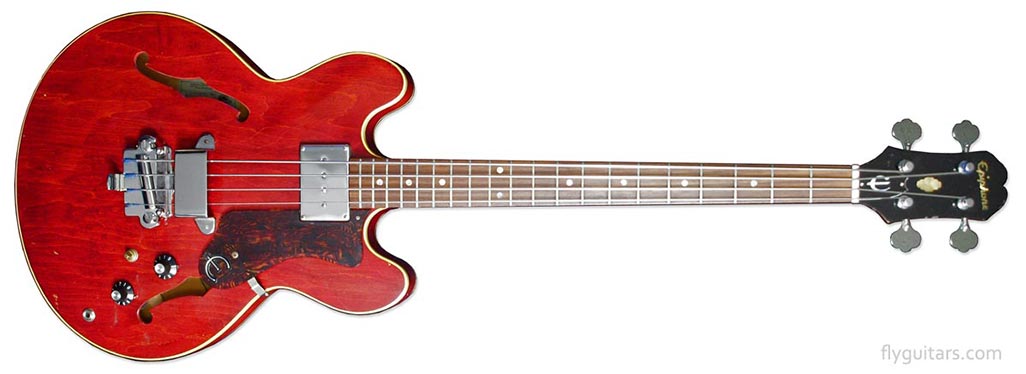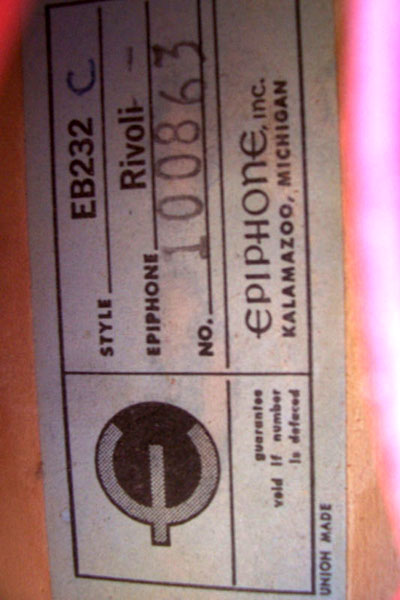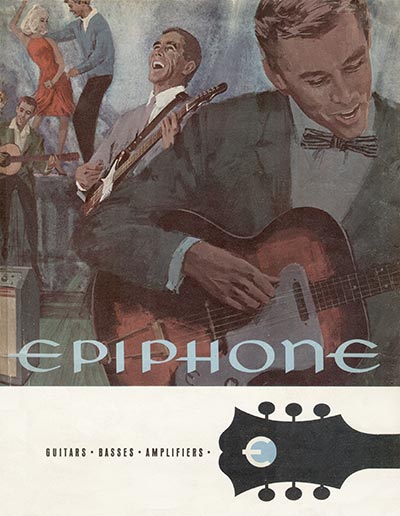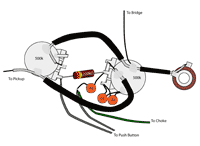• Maple top, back, sides, and centre block • one-piece mahogany neck • rosewood fretboard • single humbucking pickup • 30 1/2 inch scale
The Epiphone Rivoli was manufactured between 1961 and 1968 (excluding 1962, See the Epiphone Rivoli shipping figures) at Gibson's Kalamazoo plant in Michigan, USA. Over the course of production there were some subtle changes in the components fitted to the instrument - most obviously the bridge unit used - but with 1967 being the peak production year, the bass pictured represents the most abundant of all the Rivoli hardware configurations. It is typical for a mid-sixties Kalamazoo plant bass, fitted with chrome-plated hardware throughout: EB humbucker, bar bridge with under-bridge mute, centrally positioned hand rest and Kluson 538 tuning keys. The pale blue Epiphone soundhole label contains the model code, 'EB232C' and the instruments serial number, which is also stamped onto the reverse of the guitar's headstock.

Epiphone translucent Cherry finish
The original 1960s Rivoli was available in Sunburst and Natural finishes, with Cherry added in 1966. Just 312 instruments (out of a total US production of 1864) shipped in Cherry between 1966 and 1968. This only amounted to 17% of the total US production. The vast majority of Rivolis had the standard Sunburst finish.
This is a great sounding bass with the very distinctive, full, Gibson neck humbucker tone. This is obviously a single-pickup instrument; dual pickup Rivolis were not available until the model was reissued some 30 years later. 30 1/2 scale basses are great for playing fast runs and quickly changing positions, but short scale strings are essential (I like flatwounds for a real 60's thump - Thomastik-Infeld JF324, Pyramid Gold, and Labella Deep Talkin'). October 1966 prices (the first to include Cherry as a finish option) list Cherry finish at $375; $15 more than Sunburst at $350. By September 1967, either finish was $375. (US zone 1 prices).








Epiphone Rivoli circuitry
The Epiphone Rivoli and the single pickup Gibson EB2 shared the same circuitry: a single pickup, volume and tone control, plus a push-button switch to activate the choke. Have a look at the the wiring diagram and circuit illustrations here. Both potentiometers fitted to this bass have the same value: 500kΩ audio taper part 811-1053, and are CTS brand, with date stamps from the middle of 1967.
Epiphone Newport bass for sale
1964 Epiphone Rivoli Bass in Cherry Sunburst
London, SW6***, UNITED KINGDOM
£3800
1964 EPIPHONE RIVOLI - CHERRY SUNBURST
A Gibson EB2 in all but name, headstock and inlays this semi hollow bodied Rivoli has a laminated maple top and solid maple centre block. The pickup is the famous EB pickup also used on the Gibson EB series. Feature the Baritone switch this has that sound these basses are renowned for. The tortoiseshell Pickguard is, as usual with these missing its silver E badge. ... more
guitare bass Epiphone Rivoli VC année inconnu 1960? défrettés bass acoustics ty
Apremont, 85***, FRANCE
€590
Je répondrais au mieux à vos questions je ne suis pas musicien merci... more
I have the Sunburst model I purchased in 1967. I played it nearly every night for 20 years and it looks and sounds as good as it did when new. only three very small wear marks, it is in better shape than I am, although the hard shell case testifies to being well traveled. I use Rotosound nylon wrapped strings and get a sound comparable to my upright.








